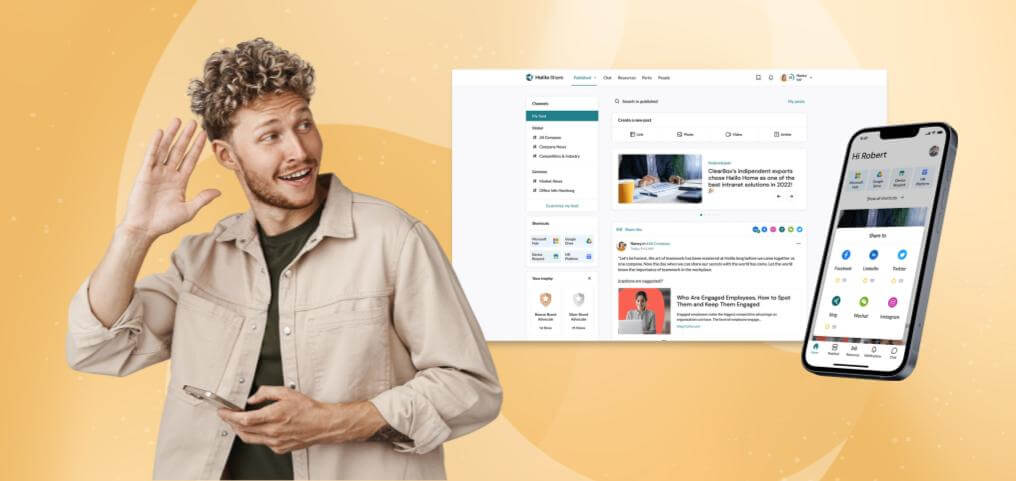Employee advocacy software is becoming one of the must-have tools in every organization’s tech stack. As employee advocacy can go a long way in driving more brand awareness, generating more sales, improving internal communications, and building pools of high-quality job candidates, it is not surprising that employee advocacy is becoming an important strategy for many organizations.
Today, we know that 83% of people trust recommendations from friends, family, colleagues over other forms of marketing – making these recommendations the highest ranked source of trustworthiness.
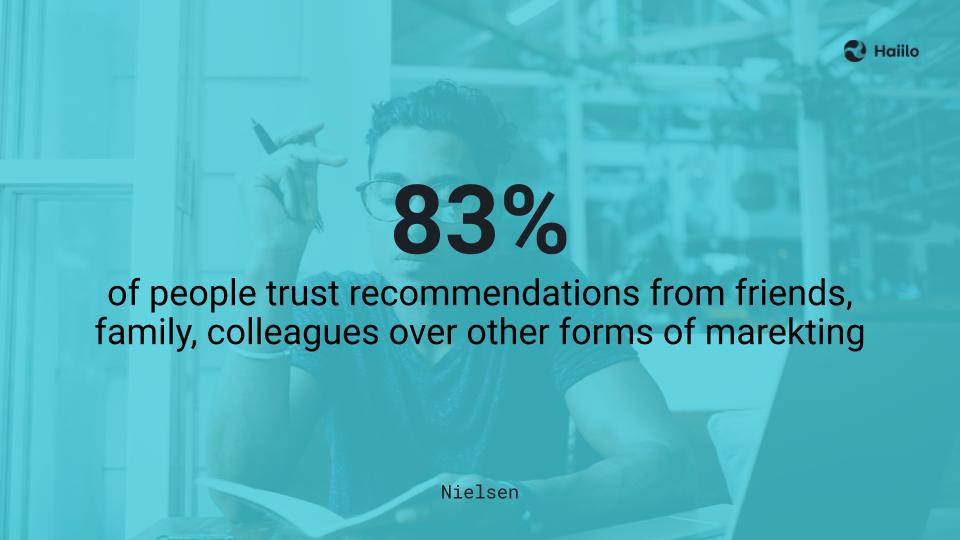
So it is not surprising that more and more marketing departments are looking for ways to better leverage their employees’ word-of-mouth to drive better business results.
Since implementing and managing a successful employee advocacy program is impossible without the right technology, we decided to create an article that will assist you in choosing the best employee advocacy software for your organization’s needs and business objectives.
What is Employee Advocacy Software
Employees are the most important assets most companies have, and yet they remain largely untapped on a platform where a vast majority of consumers communicate—social networks.
Employee advocacy software is a solution that helps organizations engage their employees in driving brand awareness, increasing visibility and engagement on social media, generating new marketing and sales qualified leads, and optimizing their talent acquisition and employer branding efforts.
With employee advocacy apps, companies can provide feeds of targeted and relevant content delivered to each employee via their preferred channels and devices, while employees can seamlessly amplify this content in a matter of seconds. In other words, they can enable organizations to eliminate the biggest challenges with employee advocacy programs.
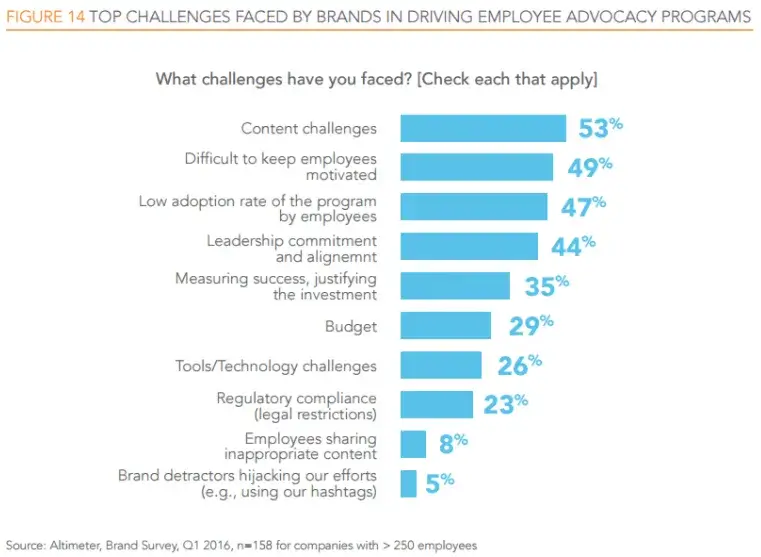
Which Departments Use Employee Advocacy Tools
Employee advocacy tools are mostly used by:
- Marketing departments such as social media teams with a goal to leverage the power of word-of-mouth marketing, increase website traffic, boost engagement on social media, build trust among buyers and prospects, and generate high-quality leads.
- Sales departments that understand the power of social selling for closing more customers, shortening sales lifecycles, building trust among prospects, and building a reputation of thought leaders in the industry.
- Human resources departments that are looking to leverage the employees’ voice in building a strong employer brand, attract more talent to their organizations, and drive more referrals.
- Internal communications departments with the goal to make internal and external communications more aligned, improve corporate branding, and better amplify compelling company stories with both internal and external stakeholders. Although many of the lines between marketing, internal communications, public relations, and digital communications are blurring, it is important to keep all the communications consistent.
💡 Also read about 3 Employee Advocacy Trends to Look Out for in 2023.
How to Choose the Best Employee Advocacy Software
Not every employee advocacy software is the same. Moreover, some solutions are cheaper and include very rudimentary features while others are much more comprehensive and scalable.
Therefore, choosing the best solution can be challenging. However, there are certain features and functionalities you should consider when choosing a perfect solution for your organization. This is particularly important for large enterprises with dispersed workforces and complex organizational structures.
In the following section, we will present 12 questions you should consider when choosing and evaluating employee advocacy solutions.
1. Does the tool help you reach employees with relevant content?
According to Altimeter, 47% of employers say that low employee adoption rates are their biggest challenges with employee advocacy. And the number of engaged employees has a direct impact on the overall revenue growth generated with employee advocacy.
According to Hinge Marketing, the more employees participate in the advocacy program, the greater is the revenue growth for the overall business.
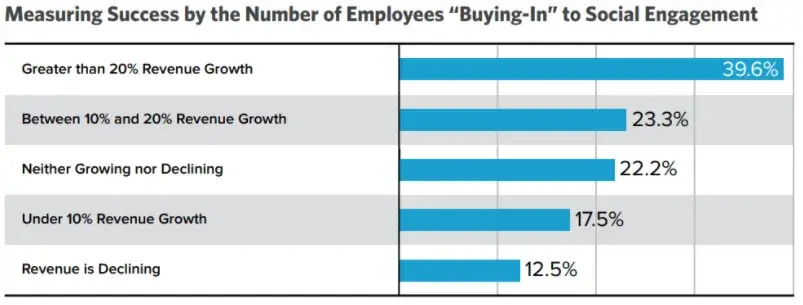
Source: Hinge Marketing
By nature, people respond to what’s relevant to them. We’re more likely to share with our friends the content that has to do with our own job functions, departments and interests.
Hence, in order to drive and encourage advocacy marketing in your organization, it is crucial that employees can access relevant and ready-to-share content in a matter of seconds. The easier it is for employees to find and share relevant content with their networks, the more engaged they will be – resulting in more impactful results.
Moreover, too much information that is not relevant to employees’ job functions, departments, locations, and interests results in information overload – one of the biggest productivity killers among employees.
Therefore, make sure that you look for a solution with sophisticated segmentation features to deliver hyper-personalized news feeds with content targeted to specific employees.
2. Does the software allow reaching employees regardless of where they are?
Large organizations today use multiple internal communications channels. As a result, it can be quite challenging to reach every employee via their preferred communication tool, resulting in employees missing the content they would otherwise share with their networks.
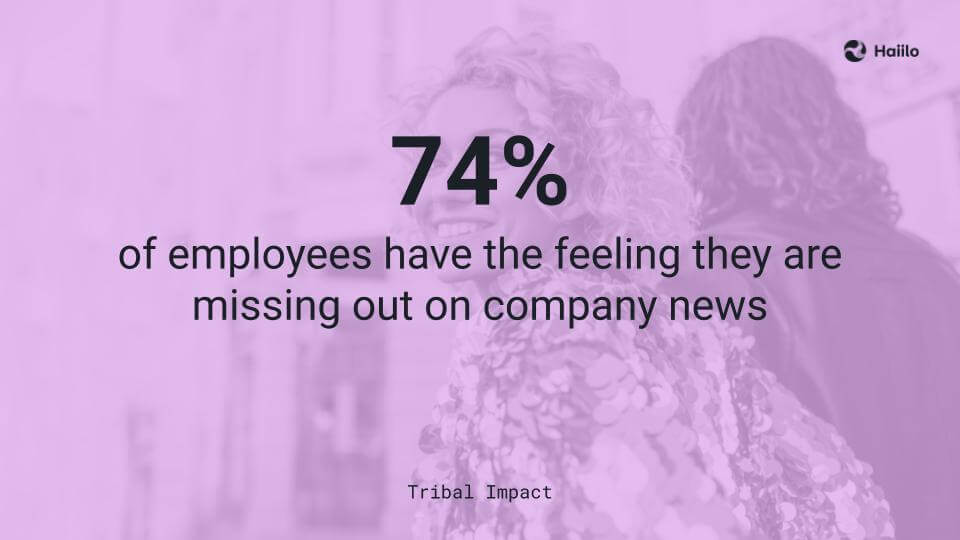
It is important to look for employee advocacy software that integrates with your existing communication solutions such as Slack, Microsoft Teams, Yammer, Sharepoint, Workplace by Facebook, or Chatter.
These integrations empower program admins to automatically distribute advocacy content to all those channels, while employees are able to share content from the channel they first saw it on. In essence, transforming all your digital channels into employee advocacy platforms!
Last but not least, ensuring timely content consumption also requires sophisticated notification systems. Proper employee advocacy solutions offer push notification features to boost visibility and ensure higher readability.
3. Which social networks does the software integrate with?
Social media marketing is an important piece of every marketing strategy.
Since social media content from employees reach 561% further than official company channels and receives 800% more engagement, there’s no question as to whether social media in the workplace is valuable.
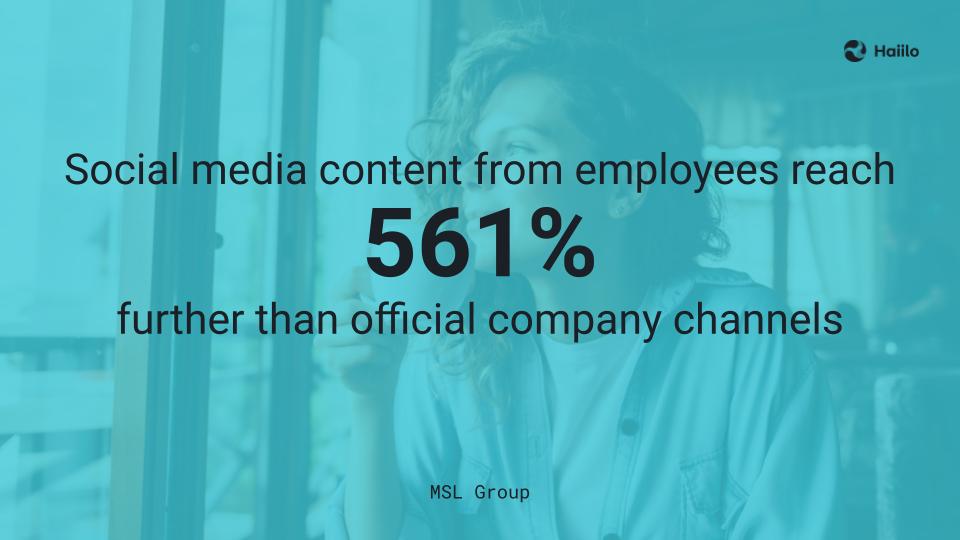
By default, many employee advocacy apps integrate with social networks. However, when evaluating different solutions, you should compare them by the number of different networks they integrate with. The more integrations, the more visibility of your social posts.
Moreover, if your offices are dispersed across the world, you should also make sure that your advocacy software integrates with social networks specific to certain regions and countries. For example, if you have employees located in Austria, Germany, and Switzerland, it is important that the software integrates with Xing – a social network with over 16 million members.
WeChat, the most popular social network in China with over 1.2 billion users, is another example of a social network that many employee advocacy providers don’t integrate with.
Furthermore, with the increase in the use of Facebook and Instagram stories, also make sure that your employees can curate your company’s content via those channels.
4. Is the solution intuitive and mobile-friendly?
Consider the following facts:
- 82% of employees keep their phones “within eye contact” at work.
- 60% of employees have seen an increase in their personal productivity as a direct result of department-specific apps.
- 8 in 10 workers say they use social media at work.

No wonder most organizations today are turning to intuitive, mobile-first workplace technologies.
Even if you are looking for robust employee advocacy software on the admin side, you should make sure that the software provides a smooth experience for the end-users on mobile. Your employees’ experience with the advocacy tool is one of the biggest factors impacting the user-adoption rates.
In addition to that, it’s important to keep in mind the frontline workers, who don’t have a desk or even a designated email address. Not including them in the advocacy initiative, you’re missing out on thousands of brand ambassadors. With that in mind, mobile-first employee advocacy tools are your best bet!
5. Does the platform empower employees to contribute to content creation?
Employee-generated content is an increasing trend in employee advocacy. Instead of just a brand promoting itself, you can empower your employees to create authentic, localized content talking about your products, services, or company culture.
Such content is extremely valuable because:
- Consumers find user-generated content 9x more impactful than influencer content.
- 50% of Millennials say that user-generated is more trusted than other media.
- They also think such content is 35% more memorable than other types of content.
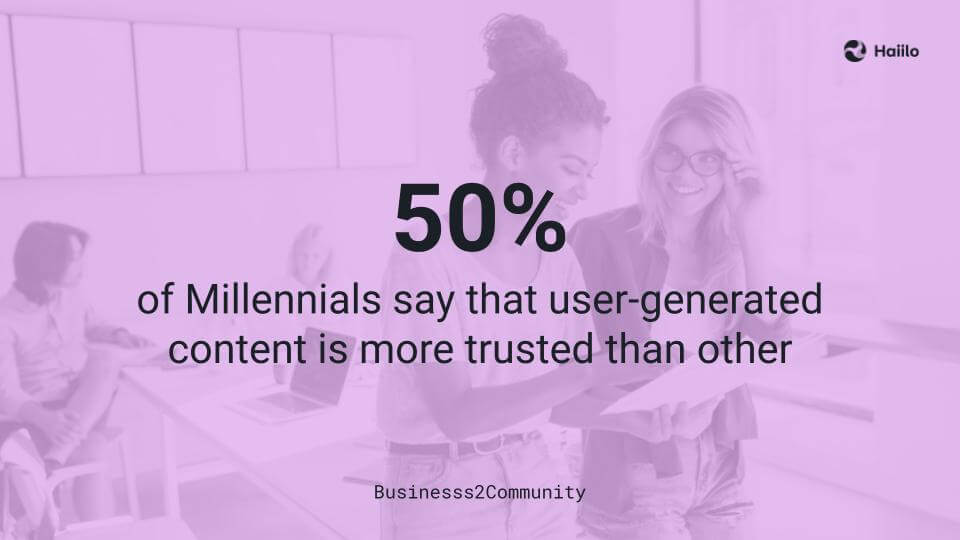
Therefore, look for an employee advocacy solution that gives employees the ability to create and consume employee-driven content to help strengthen your advocacy program.
Content creation is the biggest challenge with employee advocacy among 53% of employers, empowering your employees to create and share their own content can go a long way in easing your marketing and social media departments’ job.
However, many employers still don’t allow employee-generated content as they are afraid that this may hurt their company’s reputation. According to Altimeter, 8% of organizations think that employees may share inappropriate content with their social media audience. To overcome questions of what is and is not appropriate to post, consider an advocacy tool that provides centralized approval capabilities.
Last but not least, in order to better understand employees’ engagement with content creation, and track their content’s performance, make sure that the software offers analytics focused on employee-generated content.
6. Does the gamification feature truly encourage employee engagement?
Previously mentioned research proves that the second biggest challenge in building a successful employee advocacy program is the inability to keep employees motivated (49%).

Here, gamification features are important for driving higher employee motivation and engagement with employee advocacy initiatives. Real-time leaderboards, dashboards, and point-based rewards can go a long way in driving your employees’ motivation to become advocates.
Gamification of an employee advocacy program also ensures that your employees get recognition for their brand ambassadorship. And there’s no doubt that recognition is the special sauce that keeps your employees engaged.
A study conducted by Harvard Business Review found that 72% of employees say recognition given for high performers has a significant impact on employee engagement.
Look for a solution that makes it easy to spot the best advocates, recognize them for their achievements, and make others’ success transparent across the organization.
💡 As proper workplace communication can also be a good motivator for employees, check out our blog about the top 5 communication skills in the workplace.
7. Does the software provide analytics that helps you consistently improve?
Employee advocacy initiative is meant to contribute to the overall business success. In order to measure and improve advocacy program performance, many large organizations are looking for solutions with advanced data, analytics, and reporting functionalities. However, advocacy analytics offered by various vendors can differ significantly.
While many solutions may offer a high-level overview of your employee advocacy activities, very few providers enable program admins to drill down to data around specific groups, teams, departments, and even individual employees.
And these features are crucial, as they enable organizations to better understand their employees’ engagement and make data-driven, smarter decisions for improvement.
Furthermore, according to Altimeter, only 15% of employers measure the financial return on employee advocacy, and this is because their employee advocacy solutions don’t enable them to do so.
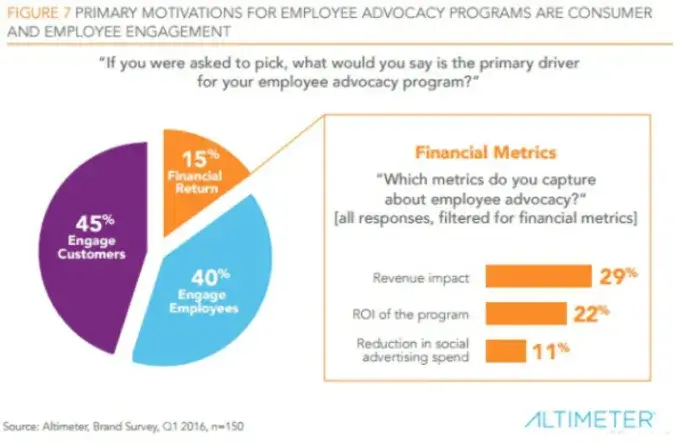
On the contrary, advanced, AI-powered, analytics offers the creation of advocacy campaigns tied to very specific business KPIs and objectives. They allow you to segment data and get answers to questions like:
- Which department is the most engaged?
- Which social media platforms are used by specific regions?
- Which type and form of content is shared the most?
- Which employee drove the most form submissions?
Being able to answer questions like these not only allow you to find out the return on investment for your advocacy initiative, but allows you to further improve and tailor the program to provide better and better results.
Additionally, make sure that the software utilizes UTM parameters that allow you to take tracking to the platforms you already use, such as Google Analytics, HubSpot, Salesforce, and more.
8. Does the software help consolidate and enhance your existing tech stack?
Modern organizations use dozens of tools in their day-to-day work, that is why most are looking for tools that consolidate the existing tech stack instead of making it even more complicated.
Large organizations have people rotating within the company, joining and leaving all the time. They have to constantly update their data in HR systems like Oracle, Workday, Azure, G-suite, etc. Adding another tool where you have to manually manage all that data is a big ask.
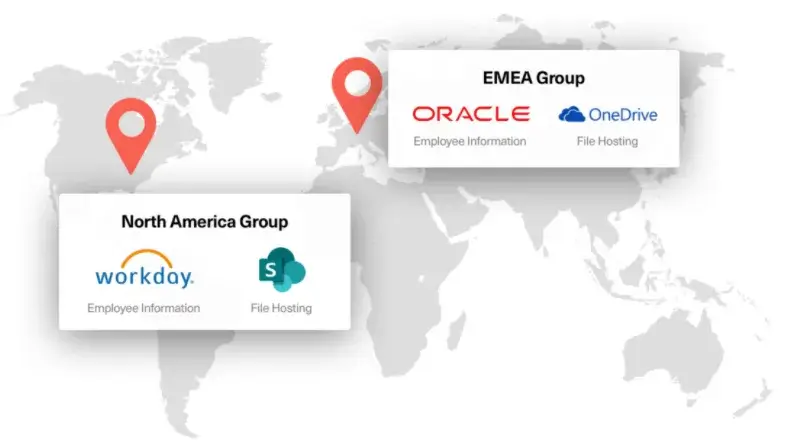
This is why it’s important to look for employee advocacy software that easily integrates into existing tools to save time in employee onboarding and user management.
Having an advocacy tool that automatically pulls employee data from the HR systems saves a great deal of time. With the data already available in these systems, an advanced employee advocacy software is able to grant or remove access whenever an employee joins or leaves the company, and assign employees to the information channels based on their role, location, and other criteria.
On the employee side, it’s important to make the adoption of the new tool as simple as possible to maximize engagement. This is where such features as single sign-on are important to save staff the hassle of maintaining a bunch of passwords.
9. Will the platform still meet your needs 2 years down the road?
When choosing an employee advocacy platform, don’t just think about your current advocacy needs. Many organizations that start with advocacy on a departmental or regional level, tend to extend on the global level after they witness the benefits of advocacy.
If you are a growing company, you should look for a solution that offers a high level of scalability to support your organization’s growth. Going from a local to global program and adding new departments, locations, and regions to your employee advocacy platform should be seamless and streamlined.
Moreover, the platform should provide flexible features around matching and supporting your organizational structure, and it should allow for multiple levels of approval, role-based permissions, and hierarchical user group management.
For the organizations who are planning to expand internationally, look for the most important internationalization features such as:
- Auto-translation & multiple language management
- Cross organization global and local content management
- Multi-country/multi-subsidiary scenario support
- Multiple time-zone management
- Geo-targeting
10. Does the vendor take ownership over ensuring the success of your program?
There is no employee advocacy solution that fits all – every organization has different advocacy needs. Therefore, when looking for employee advocacy vendors, look for a trusted and flexible long-term partner that will work with you to get the most out of your investment, collaborate with you on the product roadmap, and align the platform with your organizational goals and objectives.
Kicking off an enterprise-level advocacy program requires detailed planning and buy-in from a number of stakeholders, so it is important to look for a vendor that offers continuous support during the entire project including planning, implementation, launch, and growth.
On the end-user side, employee advocacy providers should offer multiple levels of 24/7 support including in-app support, email, and knowledge base.
11. What are existing customers saying about the software?
Existing customers are usually the best reference when it comes to choosing new software for your organization. Moreover, according to Brighlocal, 91% of millennials trust online reviews as much as friends and family.

Luckily, there are trusted software review sites such as G2 that provide credible and useful information about users’ own experience with various advocacy tools. Additionally, such websites provide users’ satisfaction with specific, must-have employee advocacy features and functionalities.
Visit G2 to research some of the best employee advocacy tools in the market.
G2 Grid® for Employee Advocacy Software
12. Is the software secure and compliant with relevant regulations?
Security and compliance are important for IT and legal departments in every enterprise. This is why it is crucial to make sure that the employee advocacy vendor has a high commitment to security, privacy safeguards, and compliance to ensure the confidentiality of employee and company information.
More specifically, look for vendors that are GDPR compliant, have data centers that ensure maximum security and continuity, and possess ISO certifications.
Get Started With an Award-Winning Employee Advocacy Software
Our award-winning employee communications and advocacy platform is used by enterprise organizations across the world. Using Haiilo, organizations have managed to successfully build and implement employee advocacy programs with high ROIs.

Organizations whose employees use Haiilo for advocacy have managed to:
- Create $200 000 worth of visibility in just 9 months
- Turn 25000 employees into brand ambassadors
- Achieve a 420% ROI with employee advocacy
- Reach 3M people on Social Media
- Lower Cost Per Lead (CPL)
If you are looking to achieve the same results and boost your sales, marketing, and employer branding strategies, schedule a Haiilo demo, and start empowering your own employees to become your best advocates.


